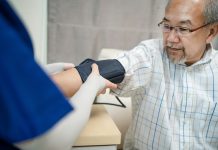
Monitoring blood pressure at home is a vital part of managing hypertension, or high blood pressure, a condition that affects millions globally.
High blood pressure is often called the “silent killer” because it usually has no obvious symptoms but significantly increases the risk of heart disease and stroke. Regularly checking your blood pressure at home can help track your condition and ensure that treatments are effective.
Traditionally, blood pressure has been measured in a doctor’s office, but this can sometimes give inaccurate readings due to what’s known as “white coat hypertension,” where patients exhibit higher blood pressure in medical settings than they do in everyday life.
Home monitoring offers a way to avoid this problem, giving a clearer, more consistent picture of your blood pressure over time.
But how often should you check your blood pressure at home? The answer varies depending on several factors including the severity of hypertension, the stage of treatment, and individual health goals. Here’s what research and guidelines generally suggest:
For those newly diagnosed with hypertension or those trying out new medications, more frequent monitoring is recommended. This could mean checking blood pressure several times a week or even daily.
The data collected can help your healthcare provider make decisions about adjusting medications or changing doses to find what works best for you.
Once your blood pressure stabilizes with treatment, you might not need to check it as often. People with well-controlled hypertension and no other major health issues might reduce their monitoring to a few times a month.
However, consistency is key, and it’s important to continue monitoring long term to catch any changes that might indicate a need to reassess treatment strategies.
The American Heart Association (AHA) recommends that individuals with hypertension should monitor their blood pressure at home regularly. They suggest checking blood pressure at the same times each day, such as in the morning and evening, to maintain consistency.
They also advise using a validated, arm-cuff blood pressure monitoring device and following specific procedures to ensure accuracy—like sitting quietly for a few minutes before taking a measurement.
Research supports the effectiveness of home blood pressure monitoring in managing hypertension. Studies have shown that people who regularly monitor their blood pressure at home often have better control over their condition than those who rely solely on doctor’s office measurements.
This improved control can reduce the risk of complications such as heart attacks or strokes.
It’s also beneficial for individuals to keep a log of their blood pressure readings. This log can be a simple notebook or a digital record on a smartphone app, which can then be shared with their healthcare provider during visits.
This practice not only helps in managing the condition better but also engages patients more actively in their health care.
For those concerned about the cost and complexity of home monitoring, it’s worth noting that many modern home blood pressure monitors are affordable, user-friendly, and readily available at pharmacies or online stores.
In conclusion, while the frequency of home blood pressure checks can vary depending on individual circumstances, the general consensus is that regular monitoring is a key component of effective hypertension management.
By staying informed about their condition and working closely with their healthcare providers, individuals can better manage their blood pressure and reduce their risk of serious health issues.
If you care about high blood pressure, please read studies about unhealthy habits that may increase high blood pressure risk, and drinking green tea could help lower blood pressure.
For more information about high blood pressure, please see recent studies about what to eat or to avoid for high blood pressure, and 12 foods that lower blood pressure.
Copyright © 2024 Knowridge Science Report. All rights reserved.



